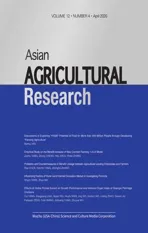Empirical Study on the Benefit Increase of New Contract Farming 1+3+X Model
2020-06-16JiaohuYANGZhongCHENGHaoZHOUPeterZHANG
Jiaohu YANG, Zhong CHENG, Hao ZHOU, Peter ZHANG
1. Nanjing CHYKINGYOUNG Biological Technology Co., Ltd., Nanjing 210014, China; 2. Nanjing Menghu Intelligent Technology Co., Ltd., Nanjing 211103, China; 3. Dongle Vine Corporation, Texas 75226, USA
Abstract For a long time, the development model of traditional rice planting industry has been single, linear, and focusing on production first and then market. However, with the low price of rice, such problems as slow technological upgrading, meager profits, and unstable rice quality in the primary industry planting units and farmers have become increasingly prominent. The integration and development of the rural primary, secondary, and tertiary industries and industrial integration have the same root. They are integrated industrial development based on technological or model innovation, vertical and horizontal integration. Three agricultural leading companies (Nanjing Tianwei Agricultural Technology Co., Ltd., Nanjing CHYKINGYOUNG Biological Technology Co., Ltd., and Jiangsu Jingshan Eco-organic Agriculture Co., Ltd.) established an industrialization complex, and used their respective technical, operational, and market advantages to integrate and form a rice contract farming 1+3+X model. This model effectively integrates scattered rice planting, rice processing, and rice sales in Nanjing City of Jiangsu Province, and Chuzhou City of Anhui Province, and unifies planting regulations and supply of production materials, safeguards the supply of green and high-quality rice and realizes high quality and high price. In addition, it integrates farmers into the entire industrial chain of contract farming,summons up the production enthusiasm of farmers and greatly increases their income from planting production.
Key words Integration of primary, secondary, and tertiary industries, Contract farming, Green and high quality, Benefit increase from multiple dimensions, 1+3+X model, Rice planting, Menghu Intelligent
1 Introduction
Since 2015, rice protection price has been canceled in Nanjing area of Jiangsu Province, then the rice price fluctuated greatly. At the same time, the prices of production input such as cultivated land rents and fertilizers kept rising, and the rice market has consecutively experienced problems of "yield increase but no income increase" and "low grain price harming farmers". The Minimum Grain Purchase Price Policy protects the interests of grain farmers, but substantial financial subsidies have entered the large acquisition enterprises and reserves, raising the processing costs of rice enterprises in the middle and lower reaches, as a result, enterprises in the processing link would obtain meager profits, the disorderly competition becomes fierce, and enterprises on the entire chain lack communication and cooperation, which is harmful for improving the quality, and leads to serious internal consumption of resources in the supply chain, as well as weak competitiveness of the industrial chain[1]. Ultimately, the profits of grain farmers are squeezed by the increase in costs and the decline in purchasing and storage prices, and the economic benefits of rice planting are low[2]. In the meantime, with the increase of people’s income level and increasing attention to food safety and nutrition issues, consumers have higher and higher demands for heterogeneity of agricultural products including varieties, specifications, quality and taste. For enterprises engaged in the agricultural product processing chain, to succeed in the fierce competition of product marketing, they must keep up with the level of consumer demands and intensify the degree of product heterogeneity[3]. In terms of ensuring the rice heterogeneity, the most important thing is to ensure the stable supply of heterogeneous raw materials, namely, green and high quality rice, and to ensure that the rice varieties and quality are qualified mainly depend on the quality of the planting inputs and the scientific field management, which is the only way of achieving high price.
2 Introduction to the contract farming 1+3+X model
The rice contract farming 1+3+X model ("contract farming" for short) is based on the integration of rural primary, secondary, and tertiary industries. Its core is to combine the interests of different industrial resources such as farmers, processing enterprises, consumer markets, enterprises of means of agricultural production, banks, to form a complex and extend the industrial chain, integrate, optimize, and reorganize high-quality assets, information and new technologies in relatively concentrated agricultural areas, save planting costs and increase production efficiency, promote the branded high-quality agricultural products to flow to the non-agricultural consumer market, and internalize the added value, and leave the value-added income to farmers. The rice contract farming 1+3+X model is based on an agricultural industrialization complex (agricultural socialization service platform), three agricultural leading enterprises (contract farming operators), and many new agricultural business entities as planting production units (large-scale new agricultural business entities), and many agricultural scientific research units, financial institutions (holders of new technologies and funds) as guarantee (Fig.1). Since 2015, this model has been implemented in Nanjing City of Jiangsu Province and Chuzhou City of Anhui Province. By 2018, the number of participant of new agricultural operators reached 21 households, including farmers and and cooperatives. The total area of cooperative rice orders was up to 3 333.33 ha. With continuous improvement, the social, economic and ecological benefits of the model have increased significantly.
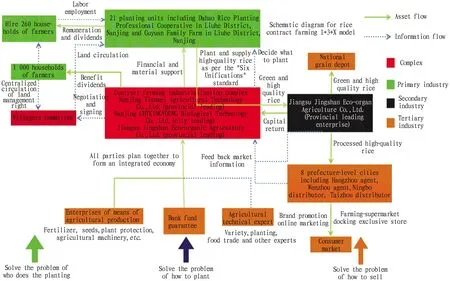
Fig.1 Schematic diagram for rice contract farming 1+3+X model
The rice contract farming 1+3+X model is a contract farming industrialization complex (Complex for short) formed by Nanjing Tianwei Agricultural Technology Co., Ltd., Nanjing CHYKINGYOUNG Biological Technology Co., Ltd., and Jiangsu Jingshan Eco-organic Agriculture Co., Ltd. Nanjing Tianwei Agricultural Technology Co., Ltd., an agricultural industrialization leading enterprise of Jiangsu Province, located in Liuhe District, Nanjing City, with the registered capital of 15 million yuan and the area of land circulation more than 266.67 ha, is a comprehensive company that integrates modern agricultural technology with agricultural production. In the intensive and efficient green organic production model of agricultural product bases, the comprehensive agricultural development and management model, and the agricultural industrialization business model focusing on the supply of socialized services, through many years of exploration, Nanjing Tianwei Agricultural Technology Co., Ltd. has achieved sales revenue of 200 million yuan in 2017, which contributed to increase of farmers’ income more than 80 million yuan. In the complex, Nanjing Tianwei Agricultural Technology Co., Ltd. is responsible for organizing planting units to circulate cultivated land for intensive production, supervising rice quality, purchasing and transportation, and cooperating with banks to provide agricultural fund services, and developing the scale of primary industry in the contract farming. Nanjing CHYKINGYOUNG Biological Technology Co., Ltd., an agricultural industrialization leading enterprise of Nanjing City, located in Jiangning District of Nanjing City, with the registered capital of 10 million yuan, owns a microbial engineering research and development center with independent intellectual property rights. The center has a building area of more than 1 000 m2, and has introduced state-of-the-art microbial research and development and production equipment. It uses high standards to set up microbial laboratory, strain storage bank, bacterial agent pretreatment workshop, and bacterial agent production workshop, and has a planting and testing base of nearly 10 000 m2. In deep cooperation with Nanjing Agricultural University, Nanjing Normal University, and Jiangsu Academy of Agricultural Sciences, Nanjing CHYKINGYOUNG Biological Technology Co., Ltd. deepened the research and application of microbial agent products in the agricultural field, and has successively obtained honorary qualifications such as Jiangsu Province Private Technology Enterprise, Nanjing (CHYKINGYOUNG) Agricultural Microbial Agent Engineering Technology Research Center, Vice President of Nanjing Soil and Fertilizer Industry Association, and has undertaken provincial and municipal government science and technology and ecological agriculture project construction for many times. Besides, Nanjing CHYKINGYOUNG Biological Technology Co., Ltd. is committed to using microbial technology to develop, produce and promote "CHYKINGYOUNG" series of microbial agents and new types of biological fertilizer products, carry out soil repair and improvement, enhance crop absorption, increase fertilizer utilization, and reduce the damage of ecological fertilizers to the ecological environment, to realize "both fertilizer and pesticide reduction", green, high-quality and high-efficiency planting production and industrialization transformation. Its remarkable effects and innovative technology have been widely recognized by experts and farmers. In the complex, Nanjing CHYKINGYOUNG Biological Technology Co., Ltd. is responsible for suppling green production materials, formulating and supervising the implementation ofManagementRegulationsforGreen,High-QualityandHigh-EfficiencyRicePlanting, organizing expert teams to provide services such as field guidance and training in planting technology, and researching the operation mode of green and high-quality rice industrialization. In the contract farming, it is responsible for ensuring the smooth, scientific and unified operation of the primary industry in terms of cost savings, as well as the technological integration of the primary and secondary industries. Jiangsu Jingshan Eco-organic Agriculture Co., Ltd., an agricultural industrialization leading enterprise of Jiangsu Province, located in Xuyi County, Huai’an City of Jiangsu Province, with the registered capital of 10 million yuan, owns a 500 TPD state-of-the-art high-quality rice production line and a 120 TPD refined rice production line, adopts advanced DSP digital color sorting process and intelligent polishing system operation, and uses big data and cloud color sorting process, 3 000 t low temperature grain storage equipment, a complete set of Japan’s original 360 TPD rice drying line. Jiangsu Jingshan Eco-organic Agriculture Co., Ltd. has won the honor of Jiangsu Famous Brand Product, passed ISO9001: 2000 quality management system certification, and green food processing certification. Its "Jingshan" and "Shuangmao" and other series products sell well in Jiangsu, Zhejiang, Anhui, Fujian, Hainan, Chongqing and other provinces (cities), and will extend to coastal and inland cities to achieve a "point, line, area" strategic pattern. It has a capacity of annual sales of 200 000 t rice. In the complex, Jiangsu Jingshan Eco-organic Agriculture Co., Ltd. is responsible for organizing the safe and green processing of rice, rice marketing, rice repurchase, and selection of planting varieties. In the contract farming, it takes its own advantages to develop the tertiary industry and undertake the final conversion of rice to capital. In the rice contract farming 1+3+X model, the target agricultural product is green high-quality rice. Through food retailers in the industry chain, it is feasible to grasp the demands of the rice consumer market, optimize the corresponding rice varieties, promote standardized planting, improve processing technology, implement brand strategies, and guide planting and production in accordance with the high-quality rice industrialization regulations. In the contract farming, the rice production uses the "Jingshan" series of trademarks, and integrates rice resources of surrounding areas, transforms the technology to improve the processing level of enterprises, and implements the "six unifications" management (unified raw material varieties, unified fertilizer and pesticide inputs, unified planting management regulations, unified repurchase quality, unified trademark identification, and unified quality management), so the quality of the green and high-quality rice produced is significantly better than that of conventional cultivation, and it has a large supply in concentrated agricultural cultivation areas, and has strong market pricing rights[4]; the purchase price of rice for orders of the same variety in the same period is 0.3-0.6 yuan/kg higher than the market price, which significantly increases the income of farmers. In organizing planting and production, the contract farming industrialization complex (complex for short) formed by Nanjing Tianwei Agricultural Technology Co., Ltd., Nanjing CHYKINGYOUNG Biological Technology Co., Ltd., and Jiangsu Jingshan Eco-organic Agriculture Co., Ltd. purchases seeds, fertilizers, pesticides and other materials, arranges aircraft plant protection and control, and dispatches harvesters and grain transport vehicles in a unified manner, which greatly saves the production costs of farmers. In response to national policies such as "fertilizer and pesticide reduction" and "green and high efficiency", the complex introduced new agricultural technologies such as bio-fertilizers, nano-pesticides, plant protection UAV, and hard-ground seedling cultivation, to turn the contract farming into an integrated platform for new technologies and new form of businesses, so as to further improve the efficiency of agricultural production, realize the scale of green planting, reduce agricultural non-point source pollution, which save costs and increase the income, and also bring high ecological benefits.
3 Data source, survey contents and analysis methods
3.1 Data sourceNow, large-scale farmers, family farms, agricultural cooperatives and agricultural companies have become the new agricultural entities in the development of modern agriculture. Contract farming is a modern agricultural production and management organization form that is based on the household contract management, adapts to the market economy and the development of agricultural productivity, and is engaged in specialized and intensive production and management, and it is the key to the transformation of traditional agriculture to modern agriculture[5]. In 2018, the contract farming implemented a total of 21 planting units in Nanjing City and Chuzhou City (Table 1), mainly a new type of agricultural entities, the average cultivated land area was 158.27 ha, and it has a strong driving force in local villages and towns, which laid a good implementation foundation for the further development of the contract farming. In this study, the sample selection method of the planting unit cost and benefit surveys for contract farming was based on the sampling survey method. The regions included Jinniuhu, Xinhuang, Chengqiao, Longchi, and Xiongzhou residential districts in Liuhe District of Nanjing City, and Tongcheng, Datong, and Zhengji towns of Tianchang City of Chuzhou City, a total of 10 order mode planting units, which can, to some extent, represent the impact of this model on the cost and benefit of planting units. Took each of the sampled 10 units 3.33 ha, and planted and produced in accordance with the normal mode, that is, the production materials were separately purchased, separately accounted, and separately harvested and weighed; other grain fields were subject to production management and income accounting in accordance with the contract farming In the contract farming in 2018, the rice planting varieties were Fengliangyouxiang No.1 and Nanjing 5055.
Table 1 Composition of order planting units-number and scale of business forms

Business categoryNumber ofplanting unitsTotal cultivatedland area∥haAverage cultivatedland area∥haPlanting cooperatives162 333.33145.80Family farms31 966.67322.20Large scale farmers223.3311.67Agricultural companies000Total213 323.33158.27
3.2 Survey contentsThe survey content can be divided into 6 parts and 14 subcategories. The first part is the input cost of production materials of the planting unit, this part is divided into 3 subcategories: seeds, fertilizers and pesticides; the second part is the production-assisted labor cost, this part is divided into 2 subcategories: field management (such as seedling planting, fertilization) and pesticide application; the third part is the input cost of agricultural machinery operations, this part is divided into 4 subcategories: land preparation, seedling raising, transplanting, and harvesting; the fourth part is the cost of irrigation inputs; the fifth part is the land lease fee, and this part is divided into two subcategories: the contracted unit price and the lease term; the sixth part is the sales of rice from conventional planting and contract farming in 2018, and this part is divided into two subcategories: average yield and unit price of rice.
3.3 Analysis methodsThe statistical analysis contents include five dimensions: input cost of production materials, total production input, average output, unit price of rice, and sales benefit. The data results are expressed as "mean±standard error". The Duncan test was carried out for one-way analysis of variance (ANOVA), and the least significant difference (LSD) method was used for significance analysis (α=0.05). Plotting was made with the aid of the software Sigmaplot 13.0, and table was made with the aid of the Excel 2010.
4 Analysis of advantage factors of rice prices in the order model
4.1 Ensuring green, high quality and price of riceThe varieties and quality of the high-quality rice repurchased in the order model depend mainly on the quality of planting inputs and field management level.
4.1.1Unified supply of means of production. In the past, the use of seeds, fertilizers and pesticides in traditional agriculture was large and not unified, which was related to the small-scale farmer-led agricultural management system, and also connected with the excessive pursuit of high-yield agricultural products and low level of agricultural production technology. The contract farming aims at the production of green and high-quality rice with the concept of green ecological development. In the planting process, a supplier of production materials consisting of famous agricultural enterprises such as Nanjing CHYKINGYOUNG Biological Technology Co., Ltd. and Hefei Fengle Seed Co., Ltd. is responsible for producing and purchasing high-quality seeds, new fertilizers, and environmentally friendly pesticides in a unified manner, and does not add price to directly sell to contracted farmers. For example, according to the fertilizer demands of rice, the characteristics of soil supply in the planting area and its fertilizer effect, it adopted CHYKINGYOUNG bio-organic-inorganic compound fertilizer as the base fertilizer for rice cultivation (total nutrients ≥ 25%, 12-6-7, organic matter ≥ 20%; replacing 45% compound fertilizers of conventional planting), to achieve fertilizer reduction and efficiency increase[6]. In addition, the combination of physical prevention and control, fixed-point monitoring and forecasting, aircraft prevention and control, and precise application of pesticides has been adopted to actively promote pesticide reduction and control, to achieve pesticide reduction and efficiency increase. Through supplying means of production in sowing, fertilizing, plant protection, and agricultural machinery in a unified manner, reducing the use of chemical fertilizers and pesticides, it not only ensures the quality of green and high-quality rice, but also greatly saves the costs of means of production for farmers.
4.1.2Unified planting management regulations. Farmers usually rely on the experience passed down from their ancestors to do planting and production, and they have poor ability to learn and master the new technologies and models required to produce high-quality rice. The complex organizes a professional team of agricultural technical experts to formulate the enterprise standardGreen,High-qualityandHigh-efficiencyRice(including three parts: production technology regulations, rice and processing regulations). It implements the "six unifications" management, namely, unified raw material varieties, unified fertilizer and pesticide inputs, unified planting management regulations, unified repurchase quality, unified trademark identification, and unified quality management. Through the "six unifications" management, the complex carefully guides the farmers throughout the seed selection-seed soaking-seedling raising-land preparation-irrigation-seedling transplanting-fertilization-unified control-water and fertilizer management-harvesting in a suitable period, the complex also organizes agricultural technical experts to provide field guidance and supervision during critical period of rice management. The ability and enthusiasm of farmers to master new technologies has been greatly improved. Therefore, this model has ensured the quality of green and high-quality rice, rice yield has also increased significantly. In summary, the quality of green high-quality rice produced through the rice contract farming 1+3+X model is significantly better than that produced through conventional planting, achieving high quality and high price in the market, and saving market costs, showing strong market competitiveness, the purchase price of the same variety in the same period is higher than the market price by 0.3-0.6 yuan/kg, and the farmers’ income-increasing benefits are obvious.
4.2 Concentrated geographical coverage, large amount and excellent price
4.2.1In Nanjing City and Chuzhou City, the contract farming implemented a total of 21 planting units, with each planting unit as the point and the adjacent roads as the lines, which are connected to form a geographical coverage of the main local agricultural cultivation areas. The area covered by the order planting will affect the rice purchase price in this area (Fig.2 and Fig.3).
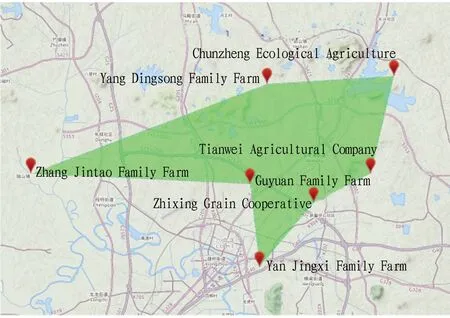
Fig.2 Regional distribution of rice contract farming in Liuhe District, Nanjing City
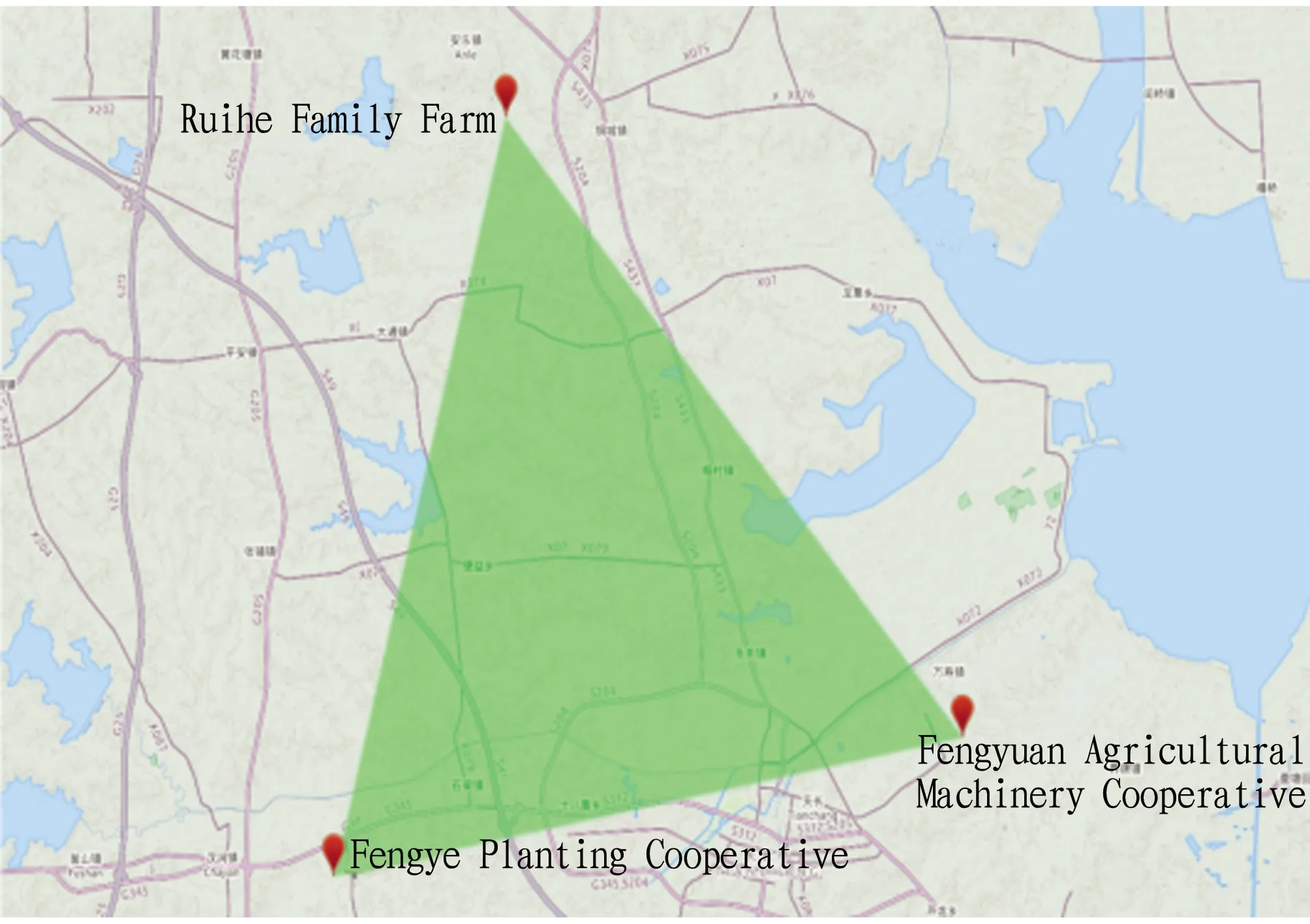
Fig.3 Regional distribution of rice contract farming in Tianchang Area
4.2.2A large and concentrated supply of rice has a greater price advantage in the market. In 2018, the contract farming planting unit covered 3 323.33 ha of grain field. Calculated at the rice yield of 7 950 kg/ha, the order was expected to repurchase 26 420 t of rice. During the same period, a large amount of concentrated rice supply will greatly affect the local rice purchase and sale balance, and has a strong rice pricing power[7]. The rice purchaser composed of the complex will adjust and deploy harvesters and grain transportation vehicles according to the rice purchase period, harvest and sell a large amount of rice in a relatively concentrated area and time, at the price 0.2 yuan/kg higher than that supplied by ordinary scattered farmers on average.
5 Empirical results and analysis
5.1 Variance analysis numerical description of the effects of different models on rice planting costs and benefitsThe 10 rice planting units are distributed in different areas and are managed by different farmers (Table 2). Different farming management levels and soil factors have a greater effects on rice yield; the unit price of rice is almost the same; inputs of means of agricultural production such as fertilizers and pesticides also vary greatly, and there is still much space of savings through agricultural technology training and standardized management; different regions and different farmers have different control over total input, which directly leads to large differences in total planting benefits.
Table 2 Effects of different models on planting costs and benefits of hybrid rice and japonica rice

Rice variety ItemModelNMeanvalueStandarddeviationStandarderror95% confidence intervalof the meanLower limitUpper limitMin.Max.Hybrid riceYield benefit∥kg/haX108 776.50387.00122.388 499.659 053.358 025.009 285.00Y108 326.50429.15135.718 019.508 633.507 515.008 925.00Total208 551.50459.86102.838 336.288 766.727 515.009 285.00Unit sales price∥yuan/kgX102.800 00.000 000.000 002.800 02.800 02.802.80Y102.637 00.158 120.050 002.523 92.750 12.492.92Total202.718 50.137 240.030 692.654 32.782 72.492.92Cost of means of produc-tionX103 469.50285.6690.333 265.153 673.853 090.004 020.00yuan/haY103 810.00277.7687.843 611.304 008.703 510.004 320.00Total203 639.75325.1372.703 487.583 791.923 090.004 320.00Total production costX109 909.00292.9392.639 699.4510 118.559 570.0010 455.00yuan/haY1010 455.00491.17155.3210 103.6410 806.369 360.0010 935.00Total2010 182.00483.09108.029 955.9110 408.099 360.0010 935.00Total benefit∥yuan/haX105 913.001 084.48342.945 137.216 688.793 600.007 275.00Y101 251.001 774.28561.08-18.242 520.24-2 115.003 600.00Total203 582.002 787.08623.212 277.614 886.39-2 115.007 275.00
(To be continued)
(Continued)
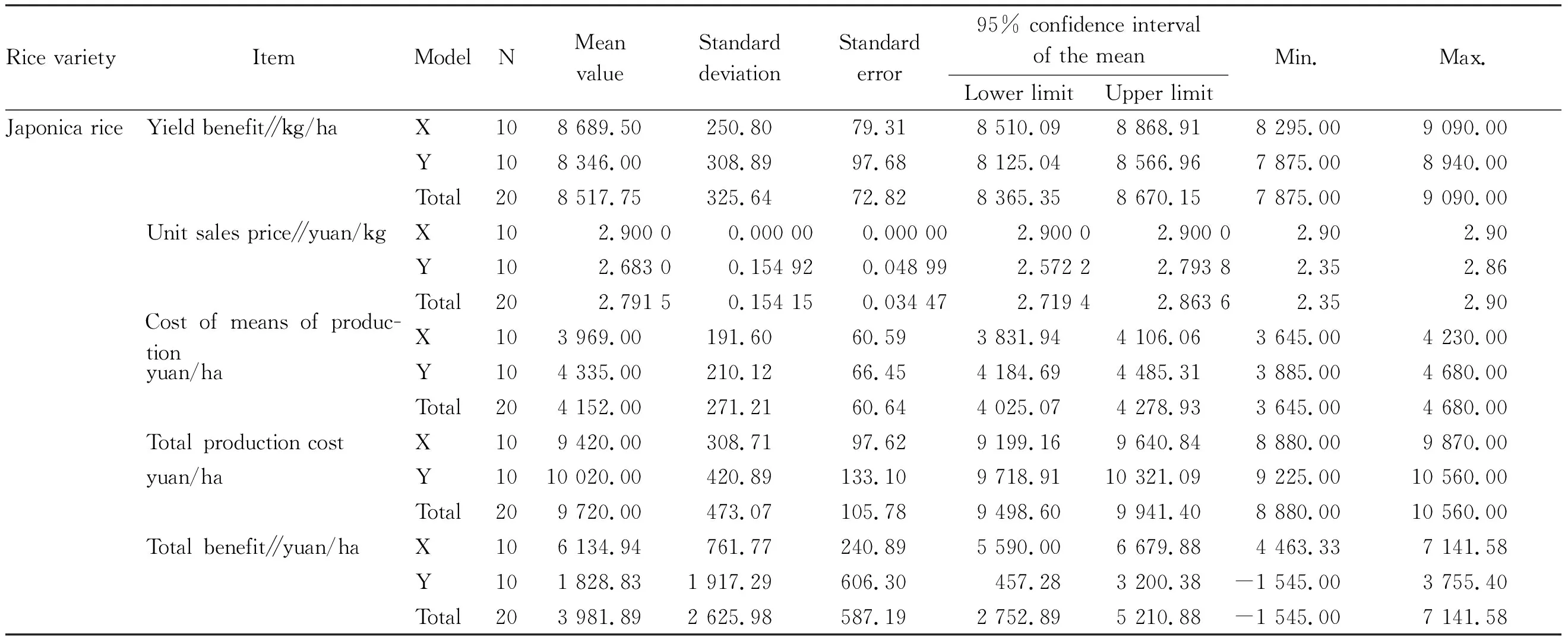
Rice variety ItemModelNMeanvalueStandarddeviationStandarderror95% confidence intervalof the meanLower limitUpper limitMin.Max.Japonica riceYield benefit∥kg/haX108 689.50250.8079.318 510.098 868.918 295.009 090.00Y108 346.00308.8997.688 125.048 566.967 875.008 940.00Total208 517.75325.6472.828 365.358 670.157 875.009 090.00Unit sales price∥yuan/kgX102.900 00.000 000.000 002.900 02.900 02.902.90Y102.683 00.154 920.048 992.572 22.793 82.352.86Total202.791 50.154 150.034 472.719 42.863 62.352.90Cost of means of produc-tionX103 969.00191.6060.593 831.944 106.063 645.004 230.00yuan/haY104 335.00210.1266.454 184.694 485.313 885.004 680.00Total204 152.00271.2160.644 025.074 278.933 645.004 680.00Total production costX109 420.00308.7197.629 199.169 640.848 880.009 870.00yuan/haY1010 020.00420.89133.109 718.9110 321.099 225.0010 560.00Total209 720.00473.07105.789 498.609 941.408 880.0010 560.00Total benefit∥yuan/haX106 134.94761.77240.895 590.006 679.884 463.337 141.58Y101 828.831 917.29606.30457.283 200.38-1 545.003 755.40Total203 981.892 625.98587.192 752.895 210.88-1 545.007 141.58
Note: Model X is "contract farming 1+3+X Mode"; model Y is "conventional model", the same as the tables below.
5.2 Significance of the effects of different models on rice planting costs and average benefitsThe 10 rice planting units separately adopt the hybrid rice and japonica rice models. By comparison (Table 3), the average difference in total yield is not significant; the unit price of rice sales increases by 0.08 yuan/kg; the difference between the cost of means of production and total production cost is not significant; the difference in total economic benefits is not significant. These indicate that there is no much difference in economic benefits for farmers choosing hybrid rice or japonica rice.
Table 3 Effects of different models on planting costs and average benefits of hybrid rice and japonica rice

Rice variety ModelYield benefitkg/haUnit sales priceyuan/kgCost of means of productionyuan/haTotal production costyuan/haTotal benefityuan/haHybrid riceX8 776.5±122.4a2.800±0.000a3 469.5±90.3a9 909.0±92.6a5 913.0±342.9AY8 326.5±135.7b2.637±0.050b3 810.0±87.8b10 455.0±155.3b1 251.0±561.1BJaponica riceX8 689.5±79.3a2.9±0.000A3 969.0±60.6a9 420.0±97.6A6 134.9±240.9AY8 346.0±97.7b2.683±0.049B4 335.0±66.5b10 020.0±133.1B1 828.8±606.3B
Note: The data in the table is the mean value of 10 production units±standard error. Different lowercase letters behind the data in the same column differ significantly at the 0.05 level, while different uppercase letters behind the data different significantly at the 0.01 level.
5.3 Analysis on multi-dimensional effects of different models on rice planting costs and benefitsThe 10 rice planting units separately adopt the contract farming and conventional models. In contrast, in terms of hybrid rice planting (as shown in Fig.4 and Table 4), the yield difference is significant, increasing by 4.7%; the unit sales price is significantly different, increasing by 6.1%; the difference between the cost of means of production and the total production cost is significant, saving 8.9% and 5.2% respectively; the difference in total economic benefits is extremely significant, increasing by 4 662 yuan/ha and an increase rate up to 372.7%. In terms of japonica rice planting (as shown in Fig.5 and Table 4), the yield difference is significant, increasing by 4.1%; the unit sales price is significantly different, increasing by 8.1%; the difference between the cost of means of production and the total production cost is significant, saving 8.4% and 6.0% respectively; the difference in total economic benefits is extremely significant, increasing by 4 306.2 yuan/ha and an increase rate up to 235.5%.

Fig.4 Effects of different models on planting costs and benefits of hybrid rice
6 Conclusions and problems
6.1 Significant benefit increase of the rice contract farming 1+3+X modelIn summary, the agricultural industrialization complex formed by three leading enterprises at provincial and municipal levels adopted the contract farming 1+3+X model to produce hybrid rice and japonica rice in Liuhe District of Nanjing City and Tianchang area of Chuzhou City. In terms of region, this model is favorable for uniting local scattered farmers to form large-scale cultivation, concentrating a large amount of high-quality rice to be put on the market in the harvest season, and forming a regional price advantage; in terms of technology, it is favorable for the unified planting management regulations of all farmers to realize scientific and standardized field management, and unified use of green and high-quality means of production, significantly increasing the yield at the same time of ensuring the high quality of rice, and significantly increasing the unit purchase price of rice; in terms of cost, the complex purchases materials in batches in a centralized manner and organizes a team of agricultural experts to conduct inspections and supervision to ensure the scientific planting management, which significantly reduces the farmers’ cost of purchasing means of production and the total cost of planting inputs. The leading enterprises of the complex give full play to their own advantages. Through the rice contract farming 1+3+X model, they have a clear division of labor in terms of regional distribution, technology update, and cost control, and have provided a large amount of green and high-quality rice with stable quality. After participation in the contract farming, farmers has significantly increased their own economic benefits, which can further enhance the enthusiasm and social value of the complex in developing the contract farming. Therefore, this model has important practical significance in promoting the integration of rural primary, secondary, and tertiary industries.

Fig.5 Effects of different models on planting costs and benefits of japonica rice
Table 4 Effects of different models on planting costs and average benefits of hybrid rice and japonica rice

Rice varietyModelYield benefitkg/haYieldincreaserate∥%Unit sales priceyuan/kgGrowthrate∥%Cost of means of productionyuan/haSavingrate∥%Total production costyuan/haSavingrate∥%Total benefityuan/haBenefitincreaserate∥%Hybrid riceX8 776.54.72.806.13 469.58.99 909.05.25 913.0372.7Y8 326.52.643 810.010 455.01 251.1Japonica riceX8 689.54.12.908.13 969.48.49 420.166 135.0235.5Y8 346.02.684 335.710 020.21 828.8
6.2 Establishing a "Contract Farming Smart Online Service Platform" to explore the resource sharing model of labor and agricultural machinery in contract farmingCompared with the conventional model, the total cost of production inputs of farmers in the rice contract farming 1+3+X model saves 6.0%, which fails to reach the original target 10% set by the contract farming industrialization complex. Through empirical research data analysis, factors such as older labor force, uneven regional, difficult employment in high season, uncoordinated skills, uneven regional agricultural machinery, and inconsistent specifications led to no decline of farmers in labor and agricultural machinery inputs, there was even increase for some farmers. In view of these problems, the complex plans to jointly organize an expert team with Nanjing Menghu Intelligent Technology Co., Ltd. to establish and improve the Internet cloud service platform "1+3+X contract farming model smart online service platform" (referred to as contract farming service platform) in 2019 and 2020[8], to make a thorough survey of the labor force’s address, quantity, and skills for all contracted farmers, survey and evaluate the address, type, quantity and condition of agricultural machinery, and input the survey data into the Internet cloud server for big data analysis, so as to realize the centralized deployment of labor, agricultural machinery, region-based, budgeted, and efficient production services through the platform, reduce the total production cost, increase labor income and agricultural machinery income of contracted farmers, form a new technology, industry pattern, and business model, and further promote the integration of rural primary, secondary, and tertiary industries[9], which has excellent business prospects and social value.
杂志排行
Asian Agricultural Research的其它文章
- Effect of Land Use on Flood Resilience
- Influencing Factors of Rural Land Internal Circulation Market in Guangdong Province
- Nutritional Quality of Oat from Different Producing Areas in China
- Effects of Herba Picriae Extract on Growth Performance and Immune Organ Index of Guangxi Partridge Chickens
- Study on the Present Situation and Influencing Factors of Farmers’ Agricultural Insurance Demand in Poverty-Stricken Mountainous Areas: Survey and Analysis of 115 Farmers in Enshi Autonomous Prefecture of Hubei Province
